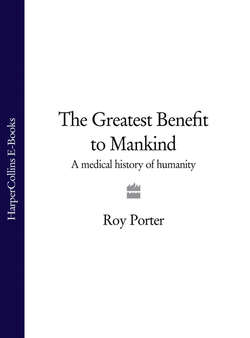Читать книгу The Greatest Benefit to Mankind: A Medical History of Humanity - Roy Porter - Страница 39
MEDICINE AND THE PEOPLE
ОглавлениеFrom the twelfth century, Europe blossomed: population rose, trade boomed, and courts and cities acquired a new sophistication. Such circumstances helped medicine. Though learned physicians were at the top of the tree, they constituted only a small fraction of all those offering medical services, and larger towns attracted a diversity of healers. Around 1400 Florence boasted not only graduates of Padua and Bologna, but bone-setters from Rome and families specializing in eye-diseases, hernia and the stone. Herbalists, midwives and pedlars of folk remedies thrived, and parish priests plied pious cures.
With numbers rising, medicine needed to organize itself. This happened first in urban Italy, where medical guilds assumed responsibilities for apprenticeship, examination of candidates, location of pharmacists and supervision of drugs, food and herbs. As early as 1236 Florentine physicians and pharmacists grouped into a single guild, recognized as one of the city’s seven major crafts.
Medical organization took various forms. In southern Europe there was no great gulf between surgeon and physician: surgery was a desirable skill for a physician to acquire. In Frederick II’s regulations for the Kingdom of Sicily (c. 12 31), a licence to practice medicine could be gained only after five years of study which included surgery, and in Italy the chance to learn surgery at university helped to prevent professional rancour between the two branches. Elsewhere the gap widened, however, for beyond Italy surgery was excluded from the academic curriculum. In northern Europe surgical training and practice were organized on a guild basis, through apprenticeship, and so were regarded by physicians as infra dig.
In Paris, the surgeons’ organization began in 1210 when the College of St Cosme (Côme or Cosmas) was established. Its members were divided into the long- and the short-robed, only the former being entitled to operate. Training was mainly practical and the college granted three degrees: a bachelor’s, a licence and a master’s. A three-cornered tussle developed between physicians of the faculty, the surgeons of the college, and the barbers, who did bleeding and the like. The introduction of anatomy added to the confusion, for dissections were under the direction of a physician but the knife-work was performed by a surgeon. Not till 1516 was the conflict resolved, with the surgeons ceding precedence to the physicians, for both could unite in antipathy towards the ‘ignorant’ barbers. In the German states and England, the barber-surgeon became typical, but in Italy, Spain and southern France, that hybrid occupation never gained prominence.
In London, the Fellowship of Surgeons came into being in 1368–9, and a Company of Barbers was chartered in 1376. The tiny band of university-trained physicians did not organize themselves until 1423, when a group led by the cleric and court physician, Gilbert Kymer (c. 1385–1463) petitioned for a joint college ‘for the better education and control of physicians and surgeons practising in the city’. Not until the founding of the College of Physicians of London in 1518 could the physicians regulate metropolitan practice. Though intra-professional conflicts flared, they were not universal. In small cities like Bristol or Norwich, physicians, surgeons and barbers found strength in unity. And, in any event, professional tussles in the late medieval centuries reflect the surging number of healers and their dawning sense of civic standing.
This proliferation provoked attempts by princes and city authorities at regulation and ‘protection’. In the Kingdom of Sicily the royal physician took charge of licensing, while in the 1340s the Aragonese King Peter licensed Jewish practitioners who had been denied medical degrees from Christian universities. Church authorities often licensed midwives, on the grounds that their morals needed to be impeccable.
Urban expansion also explains the emergence, initially in northern Italy, of community-employed public physicians. The earliest known public contracts for such medici condotti were at Reggio in 1211 and in neighbouring Bologna in 1214, where the appointee was to treat soldiers as well as citizens. Contracts typically imposed a residence requirement, balanced the doctor’s private and public duties, and set scales of fees. Especially in time of plague, the civic doctor was to assist at inquests and trials, to attend hospitals, and to tend injuries resulting from judicial torture.
This system spread. By 1300, public physicians were found in all the large towns of northern Italy; a century later the office was almost universal in northern and central Italy and in the Venetian territories in Dalmatia and Greece, and it had also been adopted in major centres in Provence, Aragon and Valencia. By 1500 civic doctors were being appointed in northern France, Flanders and many German cities, though Britain lagged behind.
Meanwhile rising urban populations contributed to overcrowding and worsening sanitary problems, due to the contamination of drinking water and food, waste accumulation and the keeping of livestock. Water began to be piped into towns, and by 1300 Bruges had built a municipal water system. Many towns paved their main thoroughfares; every large house in Paris was required to have a chamber draining into the sewers, and Milan passed ordinances for cesspools and sewers. Some German cities prohibited pig-pens facing onto the street; municipal slaughterhouses were established, and cities also tried to monitor food markets and curb river pollution. For example, tanners were not allowed to wash their skins or dyers to dump their waste in public waters. Nonetheless filth began to pose mounting threats. Plague struck in the fourteenth century (see below) and typhus from the close of the fifteenth.
